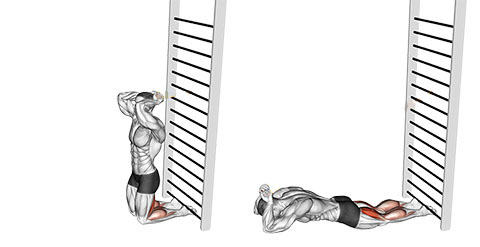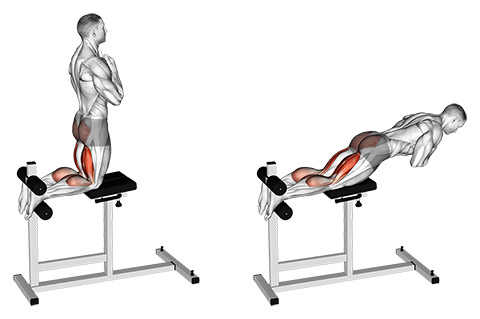Benefits of Standing Leg Curls for Strong Thighs
The standing leg curl is an exercise you perform by flexing your knees against resistance to develop your hamstrings, the posterior thigh muscles. You can use a cable machine, resistance band, a standing curl machine, or ankle weights for the exercise.
Including the standing leg curl in addition to hip hinge exercises (such as the Romanian deadlift) is essential because it allows you to isolate the hamstrings better. As a result, you can develop the muscle group more effectively.
Aside from strengthening the hamstring, standing leg curls improve your stability because your midsection muscles work hard to keep you in position. In other words, the standing leg curl is a functional exercise that can improve your athleticism and physical capacity, making everyday tasks easier.
As an isolation movement, you should include the standing leg curl near the end of your leg training once you’ve done your main work (squats, lunges, leg press, Romanian deadlifts, etc.)
How to do Standing Leg Curls
- Adjust the pad of the machine to be right above your Achilles tendon. Start with a lighter weight to get a good feel for the movement.
- Lean forward on the machine by placing your thighs against the supportive pad, grab the handles, and have the back of your legs against the lower pad.
- Take a deep breath and plant your left foot firmly on the floor.
- Curl the weight up with your right leg by contracting your hamstring muscle.
- Go up until your foot becomes higher than your knee, and you feel a strong contraction in the back of your thighs.
- Hold the position for a second and exhale as you slowly lower the weight and extend your leg.
- Take another breath and repeat.
- Once you’re done, plant your right foot and curl the weight with your left leg.
What muscles do the standing leg curls activate?
The primary muscles that work during standing leg curls are our hamstrings, the posterior thigh muscles (1, 2). Our hamstrings originate from the hip and insert into the lower leg bones (the tibia and fibula) (3). The unique anatomy of our hamstrings allows them to contribute to hip extension (such as in a deadlift) and knee flexion (such as in leg curls).
Gastrocnemius, one of the muscles in the lower leg, assists our hamstrings in causing knee flexion. The gastroc originates from the femur (large thigh muscle) and inserts into the Achilles tendon (4).
Our glutes also play a role in standing leg curls but to a much smaller degree. The muscle group provides hip stability, allowing you to remain balanced during the exercise. Similarly, midsection muscles (rectus abdominis, transverse abdominis, and obliques) flex isometrically to provide stability.
Tips when Performing a Standing Leg Curl
The first tip to keep in mind for standing leg curls is to perform each repetition with a full range of motion. Meaning, you should flex your leg until your ankle is higher than your knee and squeeze the hamstring. You then have to extend your knee fully, stretching the hamstring.
Similarly, it’s important to keep your knee steady as you flex and extend it. Avoid having your knee travel forward as you extend it and back as you flex because that can rob your hamstrings of the tension they need to grow.
Remaining balanced during the exercise is also vital for the safety and effectiveness of the activity. Many people start doing the leg curl unsupported while using lighter weights. But it becomes necessary to hold onto something as you start curling more weight.
Doing controlled repetition is the fourth crucial tip to keep in mind for standing leg curls. The goal is to use your hamstrings to overcome the resistance and control the weight as you extend your leg. You should feel constant tension in the posterior of your thighs at all times.
Variations and Modifications of the Standing Leg Curls
1. Seated Leg Curl
The seated leg curl is an effective alternative that offers many of the same benefits. You have to sit down and place your legs between a pair of pads – one over your thighs and the other behind your Achilles tendon. Once in position, begin to flex and extend your legs against the resistance.
2. Lying Leg Curl
Lying leg curls are another popular variation you can do. The objective is to lie on a hamstring curl machine and place the pad behind your Achilles tendon. Brace your body, take a breath, and curl the weight with your hamstrings.
3. Nordic Hamstring Curl

The Nordic hamstring curl is a bodyweight variation that allows you to train your posterior thigh muscles if you don’t have access to a machine. You have to secure your legs underneath a barbell or have a training partner hold them down. With your body facing the floor, begin to raise and lower your torso using your posterior musculature.
Mistakes to Avoid
The most common mistake with standing leg curls is using too much weight, which doesn’t benefit you in any way. Using too much weight prevents you from loading your hamstrings effectively and controlling each repetition. Instead, you have to resort to momentum and body swinging to move the weight from point A to B, defeating the exercise’s purpose.
Another mistake to look out for with leg curls is shortening the range of motion, often resulting from excessive loading. The goal is to flex your leg until the ankle is higher than your knee, then straighten it fully. In doing so, you train the hamstrings through a full range of motion, allowing them to grow more effectively.
The third mistake to avoid is not controlling the weight on the way down. Many trainees lift the weight through their hamstrings but then drop it to the starting position. Avoid the mistake because not controlling the eccentric contraction (muscle lengthening against resistance) robs your muscles of a robust hypertrophic stimulus.
Similar Exercises to the Standing Leg Curls
Glute Ham Raise

Glute ham raises are an accessory bodyweight exercise that strengthens your hamstrings, glutes, and lower back (1). The objective is to position yourself on a glute ham machine, anchor your feet, and use your hamstrings to raise and lower your torso.
Single Leg Romanian Deadlift
Single-leg Romanian deadlifts are a functional and effective exercise for hamstring development (1). One of the primary benefits of the exercise is the stability you develop by balancing yourself on one leg. Plus, similar to standing leg curls, you work one hamstring at a time, which reduces the risk of muscle imbalances.

